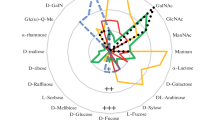Abstract
Specimens of Spirographis spallanzani (Polychaeta: Sabellidae) were collected in the Gulf of Taranto, Italy, in 1991, and their mucous secretion was examined. The mucus possesses thermolabile biologically active proteins which produce hemolysis in vertebrate erythrocytes. The molecules are ineffective against both unfertilized and fertilized echinoid eggs and spermatozoa. The lytic reaction against rabbit erythrocytes varies as a function of cations, pH and temperature, and displays a fast time-course. No immunological cross-reaction could be demonstrated between hemolysins of S. spallanzani and Eisenia foetida andrei. SDS-PAGE analysis of mucus proteins reacting with sheep erythrocytes revealed that at least three major (16, 22 and 40 kDa) and two minor (29 and 34 kDa) components interact with membrane targets.
Similar content being viewed by others
Literature cited
Anderson, R. S. (1980). Hemolysin and hemagglutinins in the coelomic fluid of a polychaete annelid Glycera dibranchiata. Biol. Bull. mar. biol. Lab., Woods Hole 159: 259–268
Bernheimer, A. W. (1990). Cytolytic peptides of sea anemones. In: Hall, S., Strichartz, G. (eds.) Marine toxin. American Chemical Society, Washington, p. 304–311
Bernheimer, A. W., Rudy, B. (1986). Interaction between membranes and cytolytic peptides. Biochem. biophys. Acta 864: 123–141
Bertheussen, K. (1983). Complement-like activity in sea urchin coelomic fluid. Devl comp. Immun., N.Y. 7: 21–28
Bonar, D. B. (1972). Feeding and tube construction in Chone mollis Bush (Polychaeta, Sabellidae). J. exp. mar. Biol. Ecol. B9: 1–18
Canicattì, C. (1987). Evolution of the lytic system in echinoderms. I. Naturally occurring hemolytic activity in Paracentrotus lividus (Echinoidea) coelomic fluid. Boll. Zool. 54: 325–329
Canicattì, C.,(1990). Hemolysins: pore-forming proteins in invertebrates. Experientia 46: 239–244
Canicattì, C., D'Ancona, G. (1990). Biological protective substances in Marthasterias glacialis (Asteroidea) epidermal secretion. J. Zool., Lond. 222: 445–454
Canicattì, C., Parrinello, N. (1985). Hemagglutinin and hemolysin levels in the coelomic fluid from Holothuria polii (Echinodermata) following sheep erythrocyte injection. Biol. Bull. mar. biol. Lab., Woods Hole 168: 175–182
Cooper, E. L., Roch, Ph. (1984). Earthworm leukocyte interactions during early stages of graft rejection. J. exp. Zool. 232:67–72
Csizimas, L. (1960). Preparation of formalinized erythrocytes. Proc. Soc. Biol. N.Y. 103, p. 157 [Cited after Canicattì, C., D'Ancona, G (1989). Cellular aspects of Holothuria polli immune response. J. Invertebr. Path. 53: 152–158]
Fizsimons, G. (1965). Feeding and tube-building in Sabellastarte magnifica. Bull mar. Sci. 15: 642–671
Fountain, D. W. (1982). Lectin-like properties associated with mucous and mucilage of diverse biological origin. Naturwissenschaften 69: 450–451
Hargitt, C. W. (1906). Experiments on the behaviour of tubicolous nnelids. J. exp. Zool. 3: 295–320
Hildemann, W. H. (1962). Immunogenetic studies of poikilothermic animals. Am. Nat. 96: 195–201
Hirigoyenberry, F., Lassègues, M., Roch, Ph. (1992). Antibacterial activity in Eisenia foetida andrei coelomic fluid: immunological study of the two major antibacterial proteins. J. Invertebr. Path. (in press)
Laemmli, V. H. (1970). Cleavage of structural proteins during the assembly of the head of bacteriophage T4. Nature, Lond. 227: 680–682
Lowry, O. H., Rosebrough, N. J., Farr, A. L., Randall, R. J. (1951). Protein measurement with Folin phenol reagent. J. biol. Chem. 193: 265–275
Maskel, S. M., Di Capua, R. A. (1988). Qualitative assays for the protease activity of Lymantria dispar unclear polyhedrosis virus. J. Invertebr. Path. 51: 139–144
Merrill, C. R., Goldman, D., Keuren, M. L. (1982). Simplified silver protein detection and image enhancement methods in polyacrylamide gels. Electrophoresis 3: 17–23 [Cited after Roch P., Canicattì, C., Valembois, P. (1989). Interactions between earthworm hemolysins and sheep red blood cell membranes. Biochim. biophys. Acta 983: 193–198]
Nigrelli, R. F., Stempien, Jr., M. F., Ruggieri, G. D., Liguori, U. R., Cecil, J. T. (1967). Substances of potential biomedical importance from marine organisms. Fedn Proc. Fedn Am. Socs exp. Biol. 26: 1197–1205
Ouchterlony, O., Nilsson, L. A. (1973). Immunodiffusion and immunoelexctrophoresis. In: Weisz, D. W. (ed.) Handbook of experimental immunology. Chapter 19. Blackwell, Oxford, p. 39–51
Parrinello, N., Rindone, D. (1981). Studies on the natural hemolytic system of the annelid worm Spirographis spallanzanii viviani (Polychaeta). Devl comp. Immun., N.Y. 5: 33–42
Roch, Ph. (1979). Protein analysis of earthworm coelomic fluid. I. Polymorphic system of the natural hemolysins of Eisenia foetida andrei. Devl comp. Immun., N.Y. 3: 599–608
Roch, Ph., Giangrande, A., Canicattì, C. (1990). Comparison of hemolytic activity in eight species of polychaetes. Mar. Biol. 107: 199–203
Roch, Ph., Valembois, P., Davant, N., Lassègues, M. (1981a). Protein analysis of earthworm coelomic fluid. II. Isolation and biochemical characterization of the Eisenia foetida andrei factor (EFAF). Comp. Biochem. Physiol. 69B: 829–836
Roch, Ph., Valembois, P., Lassègues, M., Cassand, P. (1981b). Protective activity of the coelomic fluid of the lumbricid Eisenia foetida. Devl comp. Immun., N.Y. (Suppl. 1) 5: 81–86
Sauer, K. P., Müller, M., Weber M. (1986). Alloimmune memory for glycoproteid recognition molecules in sea anemones competing for space. Mar. Biol. 92: 73–79
Valembois, P., Roch, Ph., Lassègues, M., Cassand P. (1982). Antibacterial activity of the hemolytic system from the earthworm Eisenia foetida andrei. J. Invertebr. Path 40: 21–27
Author information
Authors and Affiliations
Additional information
Communicated by J. M. Pérès, Marseille
Rights and permissions
About this article
Cite this article
Canicatti, C., Ville, P., Pagliara, P. et al. Hemolysins from the mucus of Spirographis spallanzani (Polychaeta: Sabellidae). Marine Biology 114, 453–458 (1992). https://doi.org/10.1007/BF00350037
Accepted:
Issue Date:
DOI: https://doi.org/10.1007/BF00350037



